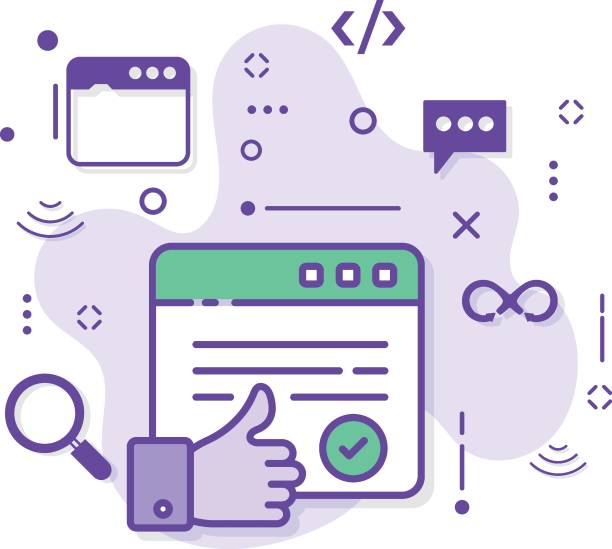Introduction to SEO-Optimized Website Design and Its Importance
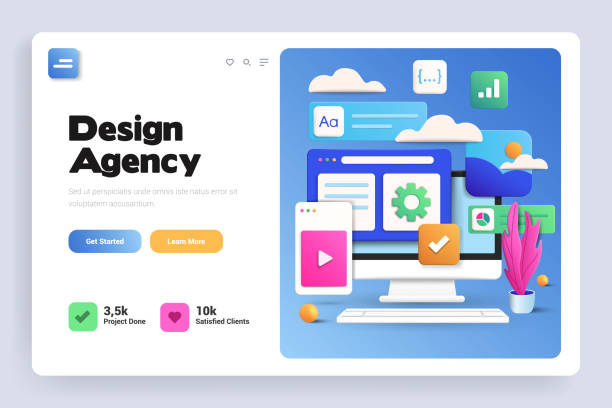
In today’s digital world, merely having a website is not enough; true success lies in its visibility.
This is where the concept of #SEO_Optimized_Website_Design becomes important.
SEO-optimized website design means building a website from scratch or optimizing an existing website in a way that is compatible with search engine algorithms like Google, to achieve a higher ranking.
This approach is not just about using keywords, but also includes technical optimization, valuable content creation, and a strong link-building structure.
The importance of this type of website design for small and large businesses is undeniable, as it directly impacts your incoming traffic, conversion rate, and ultimately, your revenue.
An optimized website can differentiate you from your competitors and attract more users to you.
Understanding and implementing these educational principles can make a significant difference in your online presence.
This process requires technical knowledge, creativity, and a deep understanding of user behavior and search engine algorithms.
By focusing on these aspects, you can ensure that your website not only looks beautiful but also performs successfully in attracting its target audience.
Frustrated by your e-commerce website’s low conversion rate? RasaWeb transforms your online store into a powerful tool for attracting and converting customers!
✅ Significant increase in visitor-to-buyer conversion rate
✅ Unparalleled user experience to boost customer satisfaction and loyalty⚡ Get a free consultation from RasaWeb!
Technical Foundations of SEO-Optimized Website Design
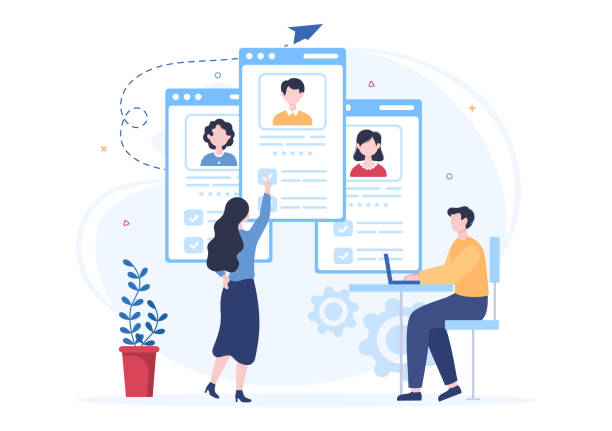
SEO-optimized website design goes beyond visual appearance and includes a set of complex technical optimizations that help search engines easily crawl, index, and rank your site.
One of the most important foundations is page loading speed.
Websites that load quickly offer a better user experience and are preferred by Google.
Using CDN, optimizing images, and reducing file sizes are among the specialized solutions for increasing speed.
Second, it’s responsiveness or mobile-friendliness.
Given the increasing use of mobile phones to access the internet, your website must display well on all devices.
Simple and descriptive URL structures, using HTTPS for security, and an XML sitemap are other vital technical factors.
Also, ensuring correct page indexing, preventing duplicate content, and managing 404 errors through 301 redirects are among the key guidelines in the technical section.
These actions not only help improve the site’s ranking in search engines but also enhance the overall user experience.
Content is King in SEO: Tables Related to Content and Keywords
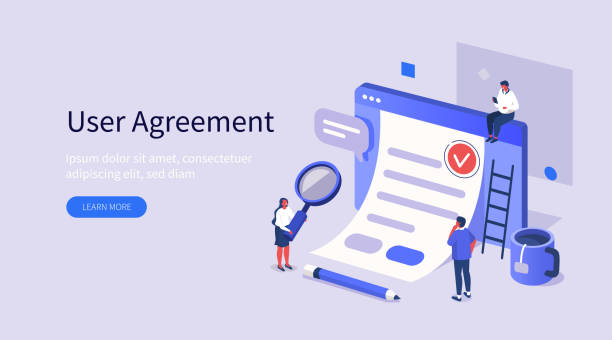
At the heart of every successful SEO-optimized website design lies high-quality and relevant content.
Content is king, and without it, even the strongest technical foundations cannot bring your website to its peak.
Creating content that is both valuable to users and understandable by search engines is an art and a science.
This includes keyword research, writing engaging texts, and using various content formats such as videos, images, and infographics.
Your content should be analytical and comprehensive, answering users’ questions.
This approach increases user dwell time on the site and reduces bounce rate, both of which are positive signals for search engines.
Below are two tables for a better understanding of content elements and how to optimize them.
| Principle | Explanation |
|---|---|
| High Quality | Unique, accurate, and valuable content for the user. |
| Relevance | Content must be directly related to the topic and target keywords. |
| Comprehensiveness | Full coverage of the topic from various angles. |
| Keyword Optimization | Natural and logical use of keywords throughout the text. |
| Proper Structure | Use of headings, lists, and short paragraphs for better readability. |
| Method | Tools/Explanation |
|---|---|
| Competitor Research | Analyzing keywords your competitors rank for. |
| Keyword Research Tools | Google Keyword Planner, Ahrefs, Semrush. |
| Long-Tail Keywords | Focusing on long and specific search phrases. |
| Google Related Searches | Checking the “Related searches” section at the bottom of Google search results. |
User Experience (UX) and Its Role in SEO
![]()
The role of User Experience (UX) in SEO-optimized website design has increasingly gained importance.
Google and other search engines constantly update their algorithms to reward websites that provide the best user experience.
An excellent user experience not only keeps users satisfied but also sends positive signals to search engines, such as reduced bounce rate, increased dwell time on the site, and higher conversion rates.
Attractive visual design, easy navigation, accessible content, and efficient forms all contribute to improving UX.
Ensuring that your site is easily navigable and that the information users need is quickly accessible is a fundamental principle.
For example, clear menus, distinct Call-to-Action (CTA) buttons, and responsive pages all contribute to this goal.
These guidelines help you build a website that is both appealing to users and optimized for search engines.
Ultimately, strong UX means users who stay longer on your site and interact more, which directly positively impacts the ranking of your search engine optimized website design.
Did you know your company’s website is the first point of contact for 75% of potential customers?
Your website is the face of your brand. With **RasaWeb**’s corporate website design services, build an online presence that earns customer trust.
✅ Creating a professional and lasting image for your brand
✅ Attracting target customers and increasing online credibility
⚡ Get a free consultation from **RasaWeb** experts!
Internal and External Link Building for SEO Improvement
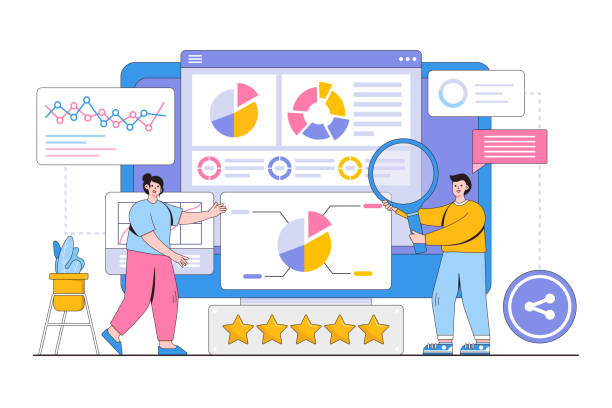
Link building, both internal and external, is one of the main pillars of SEO-optimized website design that helps search engines understand the structure and importance of your pages.
Internal link building means connecting different pages within your website.
This not only helps distribute “Link Equity” throughout the site but also allows users to easily navigate your site and discover relevant content.
Anchor Text should be relevant and descriptive to have more SEO value.
On the other hand, external link building (Backlinks) means receiving links from other websites to your site.
These links are considered votes of confidence from other sites and are one of the strongest ranking signals for Google.
But quality takes precedence over quantity; links received from reputable and relevant sites are far more valuable than a large number of low-quality links.
This is a specialized topic that requires a precise strategy and can significantly impact your website optimization.
Avoiding black-hat link-building techniques and focusing on naturally attracting links through excellent content creation is a key guideline in this area.
Advanced Tools and Techniques in SEO-Oriented Design

For a professional SEO-optimized website design, utilizing appropriate tools and advanced techniques is essential.
Tools such as Google Search Console and Google Analytics are among the most important, allowing you to monitor your site’s performance, identify crawling errors, and gain deep insights into traffic and user behavior.
Using Schema Markup or structured data is a specialized technique that helps search engines better understand your site’s content and display it in a richer way in search results (such as rating stars or event information).
Optimizing images with Alt tags and compressing them for speed improvement is also of high importance.
Additionally, implementing AMP (Accelerated Mobile Pages) for mobile pages can significantly increase loading speed.
These techniques are part of a comprehensive training in the field of SEO and help you surpass competitors and achieve a stronger presence in search results.
These tools and techniques are an integral part of an optimized website design.
Analysis and Monitoring of SEO-Optimized Site Performance: Tables Related to Performance Metrics

After implementing an SEO-optimized website design, the next critical step is continuous performance analysis and monitoring.
This process allows you to evaluate the effectiveness of your strategies, identify potential problems, and discover new opportunities for improvement.
Key metrics to monitor include organic traffic, keyword rankings, bounce rate, dwell time on site, conversion rate, and incoming links.
Tools such as Google Analytics and Google Search Console provide valuable information in these areas.
For example, through Search Console, you can detect issues related to crawling or indexing the site, while Analytics provides deep insights into user behavior and traffic sources.
Continuously tracking these metrics enables you to make analytical and data-driven decisions and implement necessary changes for continuous improvement of your site.
This informative and data-driven approach is the foundation of long-term success in SEO.
| Metric | Explanation |
|---|---|
| Organic Traffic | Number of visitors coming from natural search results. |
| Bounce Rate | Percentage of visitors who view only one page and leave. |
| Dwell Time | Amount of time users spend on your site. |
| Keyword Rankings | Your site’s position for specific keywords in search results. |
| Conversion Rate | Percentage of visitors who perform the desired action (purchase, sign-up). |
| Tool | Main Features |
|---|---|
| Google Analytics | Traffic analysis, user behavior, traffic sources, conversion rates. |
| Google Search Console | Crawling issues, indexing, search performance, incoming links. |
| Ahrefs/Semrush | Keyword research, competitor analysis, backlink analysis, site audit. |
| Screaming Frog | Technical site crawl, identification of technical SEO issues (linking, title, meta). |
Challenges and Common Errors in SEO Design

In the path of SEO-optimized website design, encountering challenges and committing common mistakes is inevitable.
One of the biggest mistakes is ignoring user experience in favor of merely stuffing keywords, which leads to low-quality and unreadable content.
Another mistake is slow site loading speed, which frustrates users and negatively impacts SEO ranking.
Lack of mobile optimization, especially considering Google’s Mobile-First Indexing algorithm, can lead to significant traffic loss.
Using broken links and not managing 301 redirects are also common technical errors that harm your site’s credibility.
Did you know that duplicate content, even across different versions of a page, can be penalized by Google? This is a point of concern that many designers and site owners overlook.
Ignoring the importance of site security (HTTPS), not regularly updating content, and forgetting the importance of content marketing are other issues that can render your SEO efforts ineffective.
The guideline for this section is to always adhere to SEO principles and avoid unethical shortcuts that might lead to Google penalties.
Worried about losing customers because you don’t have a professional e-commerce site?
With e-commerce website design by RasaWeb, forget these worries!
✅ Significant increase in sales and visitor-to-customer conversion rate
✅ Professional and user-friendly design that earns customer trust
⚡ Get a free consultation from RasaWeb
The Future of SEO-Optimized Website Design and New Trends

The world of SEO-optimized website design is constantly evolving, and to maintain success, one must keep up with new trends.
One of the most important developments is the emergence of voice search and its impact on keywords.
Users in voice search tend to use longer, more conversational phrases, which necessitates optimizing content for these types of queries.
Another is the growth of Artificial Intelligence (AI) and Machine Learning in Google’s algorithms, which allows search engines to better understand user intent and provide more relevant content.
This emphasizes the importance of creating comprehensive, authoritative, and accurate content.
The concept of E.E.A.T (Expertise, Experience, Authoritativeness, Trustworthiness), introduced by Google, shows that the credibility and expertise of the content creator and the site have gained increasing importance.
A precise analysis of these trends indicates that SEO is moving towards a more comprehensive and user-centric approach, where quality, credibility, and user experience are prioritized.
Also, the emergence of visual search and optimization for these types of searches is a new and noteworthy trend that cannot be ignored.
Keeping up with these changes helps ensure that your optimized website remains competitive in the future.
Conclusion and Next Steps for Continuous Success

In this comprehensive article, we explored various aspects of SEO-optimized website design.
From the importance of technical foundations and the role of high-quality content to the significance of user experience, link building, use of advanced tools, continuous analysis, and understanding future trends, all indicate a multi-faceted approach to SEO.
Success in the competitive online world requires a continuous and dynamic SEO strategy that never stops.
This complete explanation of this path hopefully has provided you with a comprehensive overview.
As next steps for maintaining and increasing success, it is recommended to regularly update your site’s content and add new and valuable material.
Always monitor your site’s performance with analytical tools and make data-driven decisions.
Seek to build high-quality links from reputable sites.
Focus on continuously improving user experience and keep your site optimized for mobile devices.
By following these guidelines and committing to continuous optimization, you can ensure that your optimized website design not only attracts more traffic but also achieves your business goals and maintains a powerful presence in the digital realm.
Frequently Asked Questions
| Question | Answer |
|---|---|
| What is SEO-optimized website design? | SEO-optimized website design means creating a website that is not only appealing and user-friendly for visitors but also has its structure and content optimized for search engines (like Google) to achieve a higher ranking in search results. |
| Why is SEO-optimized website design important? | SEO-optimized website design increases your website’s visibility in search engines, attracts more organic (free) traffic, enhances your brand’s credibility and trust, and ultimately leads to increased sales and customers. |
| What are the key factors in SEO-optimized website design? | Key factors include site loading speed, responsiveness (mobile compatibility), proper URL structure, correct use of title and description tags (Meta Title & Description), image optimization, high-quality and user-friendly content, and internal and external link building. |
| What is the role of content in website SEO? | Content is king. High-quality, unique, relevant, and up-to-date content that naturally incorporates target keywords plays a crucial role in attracting users and sending positive signals to search engines. |
| How does site speed affect SEO? | Site speed is one of Google’s important ranking factors. Slow sites provide a poor user experience and can lead to an increased Bounce Rate, which harms your SEO ranking. |
| What does it mean for a site to be responsive, and why is it important for SEO? | Responsiveness means that your website displays correctly on any device (mobile, tablet, laptop). Since most searches are conducted via mobile, Google prioritizes responsive websites. |
| How do we choose the right keywords for a site? | Choosing appropriate keywords is done by researching and analyzing user and competitor needs. Using tools like Google Keyword Planner, Ahrefs, or Semrush can help in finding high-volume and relevant keywords. |
| What is the importance of internal and external link building in SEO? | Internal link building helps improve site navigation, distribute Page Authority, and aid search engine crawling. External links (backlinks) from reputable sites are also a sign of your site’s authority and expertise for Google. |
| What is the role of User Experience (UX) in SEO? | Good user experience means ease of use, visual appeal, and user satisfaction with the site. Good UX encourages users to stay on the site longer and interact more, which are considered positive signals for SEO ranking. |
| What tools are available for website SEO analysis? | Several tools are available for SEO analysis, including Google Search Console for examining site performance in search, Google Analytics for traffic analysis, GTmetrix and PageSpeed Insights for speed testing, and paid tools like Ahrefs and Semrush for comprehensive SEO and competitor analysis. |
And other services of RasaWeb Advertising Agency in the field of advertising
Smart Marketing Automation: A dedicated service for growth in website traffic based on Google Ads management.
Smart Advertising Campaign: An innovative platform for improving campaign management using real data.
Smart Data Analysis: A professional solution for digital branding focusing on intelligent data analysis.
Smart Digital Branding: A combination of creativity and technology to increase website traffic through the use of real data.
Smart Direct Marketing: An innovative platform for improving digital branding by customizing user experience.
And over hundreds of other services in the field of internet advertising, advertising consultation, and organizational solutions
Internet Advertising | Advertising Strategy | Sponsored Content
Sources
Comprehensive Website SEO Guide
Online Success Strategies with SEO
Why SEO-Optimized Website Design is Important
Principles of Website Optimization for Search Engines
? Are you ready to transform your business in the digital world? Rasaweb Afarin Digital Marketing Agency smooths your growth path by offering comprehensive and innovative solutions, including professional website design, powerful SEO, and advertising campaign management.
📍 Tehran, Mirdamad Street, next to Central Bank, Kazeroun Jonoubi Alley, Ramin Alley, No. 6

